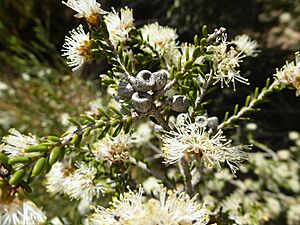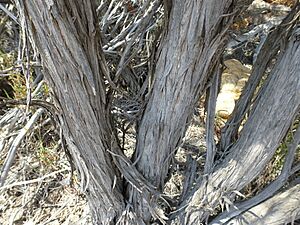South Australian swamp paperbark facts for kids
Quick facts for kids Swamp paperbark |
|
|---|---|
 |
|
| Melaleuca halmaturorum growing on the edge of a salt lake near Hyden. | |
| Scientific classification | |
| Genus: |
Melaleuca
|
| Species: |
halmaturorum
|
| Synonyms | |
The Melaleuca halmaturorum, also known as the South Australian swamp paperbark, kangaroo honey-myrtle, or salt paper-bark, is a special plant. It belongs to the myrtle family called Myrtaceae. This plant is found only in certain parts of Western Australia, South Australia, and Victoria. It often grows into a tree with a unique, twisted shape, sometimes looking like a giant bonsai tree.
Contents
What Does It Look Like?
The Swamp paperbark is a plant that grows slowly. It can be a bush or a small tree, reaching about 6–8 m (20–30 ft) tall. It often has a crooked, messy, or irregular shape. Its bark is creamy-grey and feels like paper.
Its leaves are dark green and smooth (this means they have no hairs). They grow in a special way: each pair of leaves is at a right angle to the pair below it. This makes four neat rows of leaves along the stem. The leaves are thin and shaped like a spear, measuring about 2.6–9 mm (0.1–0.4 in) long and 0.7–1.8 mm (0.03–0.07 in) wide. You can see many tiny oil glands on the underside of the leaves. Each leaf has a short stalk, about 1 mm (0.04 in) long.
The flowers of the Swamp paperbark are white or cream colored. They grow in small groups, sometimes at the very ends of branches. These branches might even keep growing after the flowers bloom! You can also find flowers where the leaves meet the stem. Each group of flowers is about 15 mm (0.6 in) across and holds up to five individual flowers. Before the flowers open, they are covered by brown, papery covers called bracts. These bracts fall off as the flowers open. The flower petals are 2–4 mm (0.08–0.2 in) long and also fall off as the flowers get older. Inside the flower, there are groups of stamens (the parts that make pollen). There are usually five groups, with 6 to 17 stamens in each group.
This plant usually flowers from August to October. After the flowers, it produces woody, cup-shaped seed pods called capsules. These capsules are about 3–5.5 mm (0.1–0.2 in) long and wide. They grow in loose bunches along the stem and can stay on the plant for several years.
How It Got Its Name
A scientist named Ferdinand von Mueller was the first to describe this plant. However, his description wasn't officially published. The first proper, official description was made by a Dutch botanist named Friedrich Miquel in 1856. He published it in a book called Nederlandsch Kruidkundig Archief.
The first plant specimen used to describe this species was found "near the Three Wells River on Kangaroo Island." The old name for a genus (a group of similar animals) of kangaroos was Halmaturus. So, the plant's specific name, halmaturorum, refers to Kangaroo Island where it was first found.
Where It Grows
The Swamp paperbark grows in the southern parts of Western Australia, South Australia, and Victoria. It likes wet, swampy areas, especially those with salty water. You can often find it in places like river mouths (estuaries), sandy areas along the coast (coastal dunes), and around the edges of salt lakes.
In Victoria, this plant is becoming less common. This is because another plant, tall wheat grass (Lophopyrum ponticum), is taking over its habitat.
Conservation Status
In Western Australia, the Government of Western Australia's Department of Parks and Wildlife says that this melaleuca plant is "not threatened." This means it is not currently in danger of disappearing.
Using This Plant
The Swamp paperbark is a very tough plant that grows well in full sun. It is often used in gardening and landscaping (this is called horticulture). People use it to help bring back plants to areas that have become too salty. It helps to make the soil better and more stable in these salty places.



